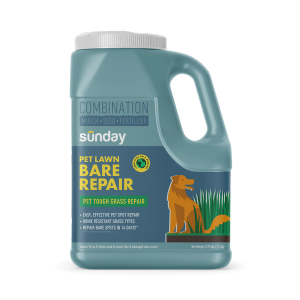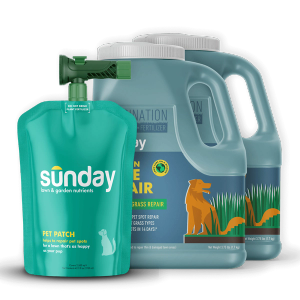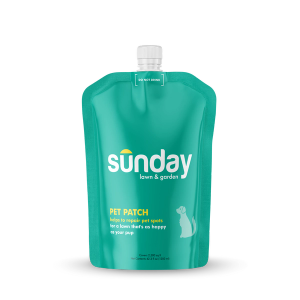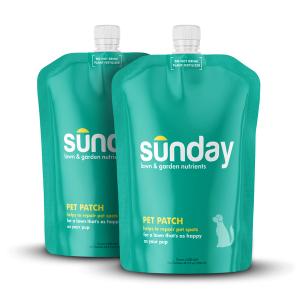Sunday Tip:
Have brown spots popped up in your lawn? Our new Spot M.D. tool instantly diagnoses spots in your lawn and helps you fix them! Check it out live—and free!—now.
Why does my lawn have brown patches?
Brown or yellow patches often occur when there are issues with watering, compacted soils, soil health, heat or drought stress, lawn disease, pet urine, or even fertilizer burn.
Identifying brown and yellow patches in lawns
It’s important to understand the cause of your brown or yellow spots because it can indicate an underlying issue that needs addressed. Learn more about the cause of these patches so you can identify them and ultimately repair your lawn.
Watering
Whether it’s overwatering, underwatering, irrigation systems in need of an adjustment, or poor drainage—water is a main culprit of brown and yellow spots across most lawns.
What to look for: Yellow or brown patches evenly spread out across the lawn, or following similar lines or angles of irrigation systems. If you have a sloped lawn, look for brown patches at the top of the slope, and soggy, yellow patches on the bottom of it.
Compacted soils
Compaction is common in clay-heavy soils, high-moisture and traffic zones, and soil with excessive disturbance.
What to look for: When soils are compacted under lawns, they tend to show this above ground with yellow to brown patches that can turn into thinning grass and bare ground.
Soil health
Most soils are generally pretty healthy and able to support grass. If you suspect you might be dealing with a deficiency, test your soil to determine if a deficiency exists.
What to look for: Nutrient deficiencies in soils have been linked to unhealthy grass patches that can range from mottled brown, to yellow, to deep purple areas.
Pet urine
The best thing you can do to limit pet spots is train your dog to “go” in a specific area—preferably a non-grass or mulched area— and raise your mowing height a bit. You can also patch damaged areas and use Pet Patch to help revive yellow spots.
What to look for: Circular yellow and brown spots in the lawn, particularly in locations where your pet frequently goes!
Heat or drought stress
When your lawn starts to take on a golden hue in the summer, it’s the grass responding to unfavorable conditions like high heat, infrequent precipitation, poor watering practices, and a lot of sun.
What to look for: Yellowing or browning occurring in a gradient—it will look more severe in the middle, and will fade out to a wilting grayish color.
Lawn disease
Diseases like anthracnose, brown patch, dollar spot, or summer patch can appear as yellow and brown patches in the lawn.
What to look for: Patches from disease will have defined edges, meaning there will be a stark contrast from yellow or brown patches to green, healthy lawn. It’s possible to have green grass interspersed in the patches.
Turf pests
Pests that cause yellow or brown patches across your lawn tend to be larvae or adult insects chewing and eating away healthy stands of grass.
What to look for: Damage from insect pests looks a lot like drought stress, but if grass pulls up easily, and you see signs of frass (insect poop), you will need to identify your turf pest and manage it appropriately.
Fertilizer burn
This is an extremely rare occurrence when utilizing Sunday nutrients as directed. Reseed and plant new grass in these areas after a few waterings.
What to look for: Streaks or irregular patterns in the lawn that follow the same pattern in which fertilizer is applied.
DIY visual test
Drought stress, pests, and disease are easy to misdiagnose because they look similar. However, you can determine what’s causing your yellow or brown patches with a DIY visual test:
- Heat or drought stress: Your grass will wilt and won’t spring back. In fact, you may see footprints on the dry lawn. As conditions worsen, the leaves will start to roll up!
- Pests: You can easily pull up the turf and spot insect frass on it.
- Disease: The leaves don’t roll up. They may twist, but will stay open, not fold or roll up. Your lawn will likely have a matted look, and you may see dark spots or powdery color on leaves.
How to get rid of brown patches on lawn
Stay off yellow or brown patches
Whether it’s watering, compaction, disease or something else, reducing traffic in these areas will help limit further damage.
Determine the underlying issue
Is it watering, soil, heat or drought stress, pet spots, disease, fertilizer burn, or a combination of a few things?
Follow DIY fixes
Follow the DIY fixes above to mend the underlying issue causing yellow and brown patches in your lawn.
Seed or plant grass into patches
Once issues are resolved, you can repair these areas by reintroducing grass into bare, thinning, or browning areas.
Restart routine lawn practices
Water, mow, and fertilize, as directed and as needed.
Go back to enjoying your lawn
You fixed those yellow and brown patches and deserve a little TLC of your own!
Preventing brown patches in lawns
Once you resolve brown and yellow patches in your lawn, Sunday recommends a few things to introduce to your routine to prevent them from coming back.
Water appropriately
Auditing your watering system seasonally, and watering appropriately, can significantly reduce issues that cause brown and yellow patches.
Follow mowing best practices
Mow at the right length, follow the ⅓ rule, do not mow stressed or wet grass, and regularly sharpen your mower blades.
Choose better grass seed
Sunday’s high-quality grass seeds are selected based on greater resistance to disease and drought, both of which cause brown and yellow patches.
Fertilize at the right time
Sunday helps you apply the right amount of fertilizer at the right time to prevent over-feeding your grass, fertilizer burn potential, and build more self-sustaining turf.
Cited sources
Animal Urine Damage in Turf. Purdue University Extension.
Fertilizer Injury - Lawns. University of Maryland Extension.
Healthy Lawns - Manage Pests, Abiotic Disorders, Nutrient Deficiencies. UCANR.
Turf: Brown Patch. UMass Amherst Extension.



















